Before I begin, an administrative note: I am going to take the Econo-Almanac offline this weekend to upgrade the site software. This should help site performance and will result in some improved functionality as well.
OK, onto the rodeo. May was a bit of a weird month as far as the median price per square foot, known somewhat more briefly as the size-adjusted median, was concerned. In specific, the size-adjusted median for single family homes was completely unchanged from April, whereas it was down a brutal 5.9% for the month for condos.
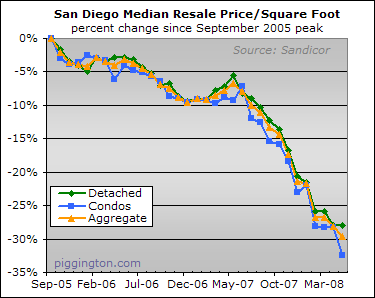
A volume-weighted aggregate of the two property types was down 2.0% for the month.
I’m not sure how much of an aberration that condo number is. It could have something to do with the switch to new MLS software, but this doesn’t seem to have affected single family prices at all. And it could be noise, but the whackage was pretty extreme to just be noise. On the other hand, the contrast between condos and single family homes is probably the biggest disparity we’ve seen so I wouldn’t make too much of this one month’s condo behavior.
Still, if you do assume that this figure is representative of actual prices, condo prices are down 32.5% from the peak. Ouch. And the 28.0% decline in single family homes isn’t exactly a walk in the park either.
The plain vanilla median was relatively stable for both property types, as it has been of late:
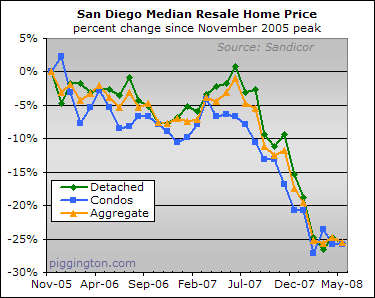
My Case-Shiller HPI proxy (like the HPI itself) only includes single family homes, so the condo whackage didn’t have an effect. The proxy implies a moderation of the price decline in May, which may be as close as we get to a spring rally:
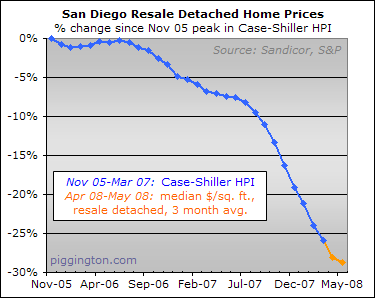
In brighter news, the supply and demand situation improved again. As the below chart shows, we were not that far off from the sales pace as of a year ago. This pace wasn’t exactly speedy, but May’s year-over-year comparison (-5.2%, to be exact), is a lot better than the 30%-plus annual declines we were seeing as recently as January.
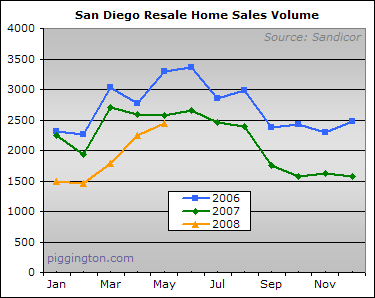
Last month, according to data posted by SD Realtor, the volume boom was concentrated in the lower-priced areas that have been absolutely decimated in price, while the high end areas continued to languish volume-wise. If anyone has observations on the geographic volume disparities (and any geographic disparities, for that matter), we’d love to hear about it in the comments.
Inventory also improved, as we were a just hair’s breadth from last year’s level:
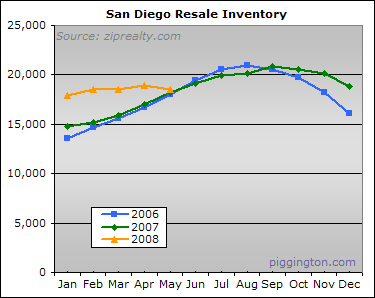
These two stats combined for make for another big improvement in the months-of-inventory figure, which also came within striking distance of last year’s level. The current 7.6 months of inventory is still in or near bear market territory but as you can see it is a huge improvement from what we were seeing earlier in the year:
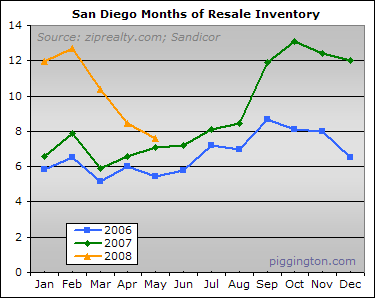
The significance of the total inventory figure has been a matter of great controversy here at the Pigg. The question is how meaningful the decline in overall inventory is when the future supply of must-sell inventory (the most damaging kind) continues to skyrocket:

I myself don’t see much of an aggregate bottom coming anytime soon while foreclosures continue to pile up at such record-shattering rates. The 1990s bust saw prices fall for 6 years in the face of a foreclosure rate that was barely more than 1/3 what we are seeing now. The pickup in sales is certainly a candle in the dark, but it just doesn’t mean all that much when those sales continue to be overwhelmed by a torrent of new foreclosures.

My anecdotal observations
My anecdotal observations (on Realtor.com) for Rancho Bernardo condos tend to corroborate these figures.
In June of 2006, my landlady sold the 2BR condo I was renting for $327,000. Today, similar condos are listing for in the $250,000’s. (“Summit” complex, 890 sf 2BRs). That’s about a 24% decline in RB overall. I can well believe larger declines in less “sticky” areas, to give a 32% decline overall.
Side note, about 4 or 5 of the RB apartment complexes condo-ized in the last 2 years, and it appears they are still trying to unload them. It also appears there may be a lot of desperate flippers in these same complexes, as I see a lot of rentals on Craigslist for RB which are obviously-new condos, with the granite countertops/stainless steel appliances bling installed. (I swear the latter are the popcorn ceilings of our day.)
>chirp<
We’ve been seeing annual
We’ve been seeing annual sales volume decline since 2003, IIRC. Though sales volume did skyrocket in spring 2004 (peak of the mania, IMO), it died out by that summer.
So, we had the following series of events:
-2003 saw peak sales (and peak refi activity?)
-2004 saw record low inventory and highest volume of sales in a quarter (spring 2004) — lowest “months of inventory” in history, IIRC. Also saw the “blow off top” price movement during this time, when prices were rising by tens of thousands (or more!!!!) each month.
I believe the transition point in SD, happened around June/July of 2004. From that point on, inventory increased, sales volume decreased, and DOM increased.
-2005 saw peak prices and the first glimpse of YOY sales volume declines
-2006 saw steep sales volume declines and slowly declining prices
-2007 saw steep sales volume declines and price decreases accelerated.
-2008 sees **rate** of sales volume decline slow (as it should; I’ve read that volumes are anywhere from 60-75% down from peak volume…it won’t go to zero). We also see record foreclosures, and this is what is causing sales declines to slow because lenders are finally getting real, and pricing as if they want to sell. Investors (knife-catchers, IMO) are beginning to move in because you actually CAN get positive cash flow from rentals in a few areas.
————————-
All that being said, I think current “investors” are not considering the fact that we are just beginning to experience the deflation of a **credit bubble,** not a housing bubble. If it were only about housing, I’d be buying a few properties myself.
We’ve seen massive credit expansion that had its roots in ~1982 (some could argue it began before that, but I like to keep it simple). I think what’s happened from 2001-2007 was the hyperbolic move in the credit markets as central banks began “pushing on a string” to avoid deflation.
As long as we have globalization (especially wage arbitrage), deflation is the primary undercurrent in the U.S. The central banks have propped us up with more debt which either has to be repaid (can’t happen…we don’t have the money) or repudiated via wholesale bankruptcy — hyperinflation/currency collapse. Whoever figures out how to play this will be the big winner.
Just for fun, if you want to see where I get the 1982 date, check out credit market charts and asset price charts (stocks, housing, etc.) over decades. It began with Reagan/Greenspan, and ended with Greenspan…
Just MHO.
CA Renter – I agree with you
CA Renter – I agree with you that the ‘bubble’ started earlier than most people commonly talk about
History tells us that financial bubbles always (yes, always) unwind back to their starting point so trying to project where prices will bottom is as easy as deciding when the bubble started
The most common bubble start date given around here is 2002 or 2001 – this date is supported by some of the charts which show price vs rent, price vs income, etc – these charts make it obvious that something changed in the early 2000’s
I use the 2001/2 date and assume an overshoot of the trendline as prices come down (another common occurrence as financial bubbles unwind) – using this methodology I predict a bottom as low as 1998 prices
What facts might support the idea that the bubble started before 2001/2?
The tax exemption for real estate capital gains on a primary residence started in 1997
Greenspan warned us about irrational exuberance in 1996
Greenspan became Fed Chairman in 1987 and began pumping credit / debt / money not long after
1982 is when the bull market in equities started – was this caused by some easing of credit / money pumping?
~
I believe you are suggesting, CA Renter, that the bubble that is currently unwinding isn’t just a real estate bubble – it is actually a credit bubble that started in 1982 or perhaps even earlier – there are other analysts who would agree with you
There is lots of debate on the internet about inflation vs deflation – consensus seems to be that, given a choice, the Fed and politicians will choose hyper-inflation over deflation – IMO the aftermath of a hyper-inflation is deflation so one way or the other, deflation is probably in our future
Interesting times …
I use the 2001/2 date and
I use the 2001/2 date and assume an overshoot of the trendline as prices come down (another common occurrence as financial bubbles unwind) – using this methodology I predict a bottom as low as 1998 prices
4plex …
Do you mean nominal prices ?
Or do you mean adjusted by income, rents or inflation ?
Trying to account for
Trying to account for inflation (monetary debasement) when making long-term projections is a fools game IMO
Are we going to use the government’s CPI number? That would be a waste of time – why spend any time doing analysis using bogus numbers?
Are we going to use the inflation numbers from shadowstats.com which currently show monetary debasement running around 17%? These numbers are probably more accurate but, if you publish analysis based on these numbers, you will be called a doom-and-gloom super-bear and will never be accepted by mainstream media.
What about the Amero? How do we account for the introduction of a new fiat currency as the old one fails? No fiat currency in history has escaped destruction at the hands of politicians and bankers – to think that the US dollar is somehow immune to this fate is naive, to say the least. (Fortunately for the powers that be, Americans are horrible students of history and would rather be entertained than educated, but that is another rant for another day …)
My philosophy on investing is to identify secular trends and get onto the right side of them
Right now real estate is in a secular bear trend and will be so until at least 2012
Right now the precious metals are in a secular bull trend that will last until at least 2014 and quite likely, much longer
Stick with the big picture and you’ll do fine
~
Inflation is confusing as all get out – to get some insight into the effects of inflation (which is really monetary debasement), go to stockcharts.com and enter “$INDU:$GOLD” then change Periods to Weekly and hit Update – this chart shows the effect of inflation on stocks – although the Dow is near its nominal high, it has lost significant purchasing power against gold which is responding to monetary debasement
“$HGX:$GOLD” shows how real estate is doing relative to gold
Spend a few minutes with this
Spend a few minutes with this chart
http://www.mises.org/content/nofed/chart.aspx?series=TMS
graph all of the measures of money and compare them
hard to say at what rate our currency is being debased, but this chart makes the debasement very obvious
I’ll try again with a simple
I’ll try again with a simple yes/no question …
RE: “I use the 2001/2 date and assume an overshoot of the trendline as prices come down (another common occurrence as financial bubbles unwind) – using this methodology I predict a bottom as low as 1998 prices ”
You mean nominal prices ?
Yes or No.
4plexowner wrote:Spend a few
[quote=4plexowner]Spend a few minutes with this chart
http://www.mises.org/content/nofed/chart.aspx?series=TMS
graph all of the measures of money and compare them
hard to say at what rate our currency is being debased, but this chart makes the debasement very obvious[/quote]
Cool charts.
I spent a few minutes. I downloaded the data. It seems to me that the money supply as measured by either M3 or TMS has been growing exponentially since the beginning of each chart in 1959.
For example in the 30-year period from 1959 to 1989, TMS grew from 283.3 to 1736. This is a factor of 6.1x increase over a 30-year period. This corresponds to a 6.21% average annual growth of the money supply.
The 30-year period from 1978 to 2008, TMS grew from 859.3 to 5474.8. This is factor of 6.4x increase in money supply over a 30-year period. This corresponds to a 6.38 % average annual growth of the money supply.
Edit …
For kicks I plotted the growth of Total Money Supply on a log scale. For those who aren’t aware, a constant rate of growth shows up as a straight line when plotted on a log scale. Below I compare the TMS from the link provided above along with a straight line. Although there tend to be some rather large excursions (most notably the flattening and rebounding in the early 1980’s) the TMS has risen by over 6% on average over the past 50 years. Seems to me that our currency has pretty been fairly consistently in the process of being debased since way back when my Dad used to buy soda for 3 cents a bottle.
[img_assist|nid=7933|title=Total Money Supply Growth|desc=|link=node|align=left|width=100|height=75]
FSD – you made me think about
FSD – you made me think about what I mean by 1998 prices
Let me answer your question by referring to some of the charts Rich has provided us over the years
I will be referring to articles that are available on this site via the Bubble Primer link
article: Evidence of a Southern CA Housing Bubble
chart: Median Home Price Divided By Per Capita Income: San Diego-Carlsbad-San Marcos
chart: Rents and Home Prices: San Diego-Carlsbad-San Marcos
article: Risks of a Serious Home Price Decline
chart: San Diego Home Price to Income Ratio – “Soft Landing”
article: This Just In: San Diego Homes are Overpriced
chart: San Diego Home Price to Income Ratio
chart: San Diego Home Price to Rent Ratio
In all of these charts, 1998 is an obvious bottom and I believe we will return to those points before a sustainable bottom is in place in San Diego
4plexowner –
Thanks, I’ve
4plexowner –
Thanks, I’ve read and referred to the primer articles many times.
So, I interpret your 1998 comment to be reverting to price-to-(insert metric here) ratios of ~ 1998where the metric is income or rents. (in other words the answer to the yes/no quesiton is “no”, unless rents and salaries also fall to those levels).
I agree with that.
The thing to keep in mind is that there are people who think we are headed to the nominal prices from 1998 (e.g. median in the 180K range or less in San Diego) or even 1991. What tends to be forgotten is that a decade or two of rent and wage increases (however meager they may seem) have resulted in both rents and wages that are on the order of 50% higher than in 1998. That’s why I tend to try to clarify what people mean by reverting to 19XX prices.
FWIW, I agree with both of
FWIW, I agree with both of you. 🙂
I also believe prices will not hit “bottom” until 2012, though different areas will bottom at different times, I think waiting until 2012 wouldn’t be a bad idea, as long as you keep an eye on inflation/wages/general economy.
One thing many people don’t seem to be taking into consideration is the effect of Baby Boomers on all markets (housing, stocks, bonds, etc.). We’ve been accustomed to inflation for so long that it’s considered a “given” in most prognostications.
Also, one doesn’t have 30-year employment with the same company any more — with DB pensions and retirement healthcare perks. We are also competing even more with other developing countries for resources, which might make all those “other” living expenses rise relative to income — leaving less money for housing costs. Incomes are trending down, too, for most Americans.
IMO, many conditions merit a different perspective WRT the housing market. Maybe we won’t see peak prices (inflation-adjusted) in our lifetimes??
I think inflation is the easy way out, but might there also be an argument in favor of long-term deflation?
Good summary CA renter.
As to
Good summary CA renter.
As to when the bottom will arrive giving us the proper time to jump in, let’s remember one thing past cycles can tell us. Extreme movements either to the upside or the downside tend to overshoot. That is, the pendulum swings past the “normal” or “fair value” level due, I think, to market psychology and emotion. This is observable in stock market swings, real estate, commodities, etc.
If this is true in the current real estate downturn, one should wait until total despair and capitulation set in and the assumed wisdom is that real estate is the dumbest thing to invest in. Clearly, we are not there yet.
Also, investors who are finally discovering they can now barely cash flow on rental houses now in some areas are way premature. Past cycles have shown the time to buy is only when very good cash flow can be realized, including taking ALL landlording costs into account.
Market psychologists say that
Market psychologists say that it is the capitulation that allows a lasting bottom to be put in place – prior to that there is lots of knife-catching as people assume each cyclical upturn marks the start of a new, lasting rise in prices
I expect capitulation to occur in our local market in 2012 as the peak of the Option ARMs (which were used extensively in our expensive markets) fall into the NOD / NOT cycle – RE markets are likely to have declined for each of the preceding 4 years so distress sellers in 2011 / 2012 will be hitting the market at a very bad time
“Capitulation in 2012” – sounds like a political slogan